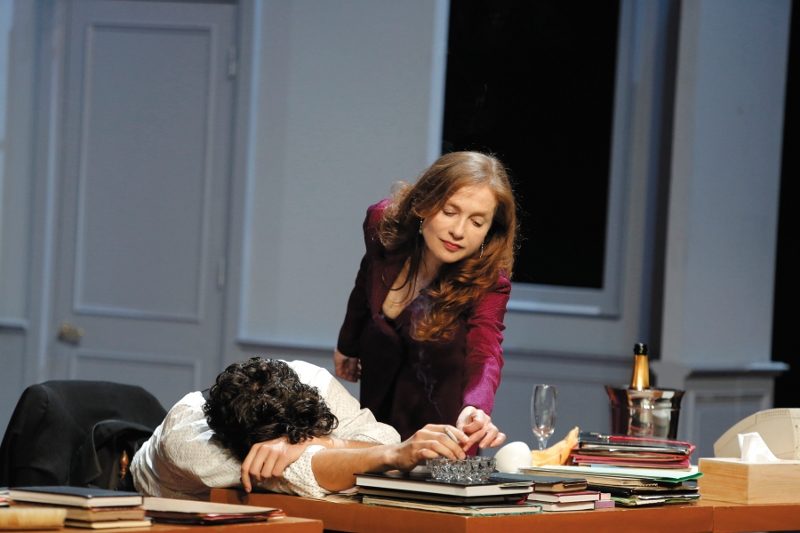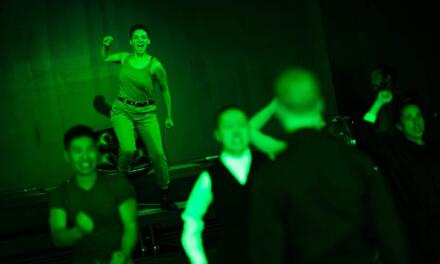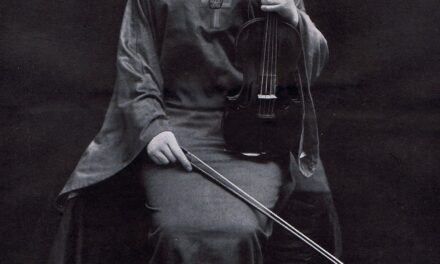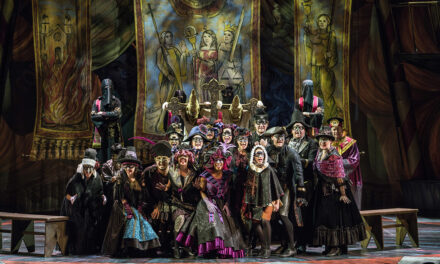American playwright, translator, and journalist Amelia Parenteau is currently in residence in Paris, France, where she will be writing about the contemporary theatre scene in that city for TheTheatreTimes.com. Her second article is a comparison of the New York and Parisian theatre systems.
Parisian theatre, or at least, the Parisians, are going through a tough time right now. To look at the city or attend a play, you would have no idea — houses are still packed with audiences who applaud until their hands are ready to fall off. However, there is a cultural malaise infecting the Parisians, due to the resurgence of conservatism in politics and the lingering effects of the 2009 financial crisis. Everyone is talking about it: my landlady shakes her head over the job prospects for young people, my doctor bemoans the loss of French culture due to immigrants’ cultural influence, and even my best friend, a twenty-three-year-old architecture student, is wringing his hands over the way that French culture is retreating back to its older, more conservative values. I had an author say to me this fall, in light of the French government’s recent cuts to arts funding, “What are we, animals?”
In short, French culture isn’t what it used to be. Although the value placed on arts and culture is certainly still more universal in Paris than in other cities of comparable size and wealth, it’s no secret that Paris is no longer the singular hotbed of the foremost intellectuals and artists, although it has managed to generally maintain that romantic image. The prevailing sentiment is that of nervous despair, as Parisians watch their cultural identity change in ways that they feel they have no power to change.
And yet, the show goes on! There is certainly no shortage of theatre happening in Paris. For example, the week of November 5-11, there were 379 shows playing in Paris. There also is no lack of publicity for theatre (and culture, in general). The metro stations are filled with posters, the streets present billboards in medium and large format, and handy little periodicals such as l’Officiel des spectacles and le Parisien give complete listings of what’s on in Paris. And of course, there is the internet. After two months back in Paris, having seen ten performances, and spent a couple of hours perusing the aforementioned issue of l’Officiel des spectacles, here are some of the most striking points of comparison between Parisian theater and New York theater, which help to explain why the cultural malaise has sunk such deep roots here in Paris.
First off, the economic structure/hierarchy of theatres in Paris is quite different from that of New York, although they might appear similar, at first glance. Whereas Broadway is perceived as the pinnacle of New York theatre, the government is the purveyor of culture here, not the almighty dollar, and so the national theatres are considered to be the most reputable. State-funded theatres in Paris have bigger budgets and more opportunities to draw big acts. They tend to see more international work and they love, above all, to re-stage the classics.
A step down from Broadway in New York, we have Off-Broadway theatres, mid-sized with a considerable budget, and tremendous power in selecting the up-and-coming voices in American theatre. In Paris, the mid-sized private houses belonging to a group of 50 theatres called “Associated Parisian Theaters.” On their website, these theatres call themselves “producing theatres,” who, as entrepreneurs without government subsidies, defend their artistic independence and promote the diversity of their programming. The Associated Parisian Theaters share strictly professional standards: they respect the rights of authors and artists, they respect their audiences, and they preserve a high-profile architectural and cultural heritage. And yet, the programming in these theatres tends to be a far cry from what is seen in the national theatres, and it is almost unthinkable that a production could move from a private house to a national theatre. These theatres are also referred to as “boulevard” theatres, a reference to their tradition of providing spectacles that were a pure amusement to their general public, including vaudevilles and whodunnit plays. American theatre sells out to Broadway for big, flashy, expensive spectacles that give the viewer their money’s worth. French theatre sells out for a different price: their bread and butter. Medium sized theatres have to produce feel-good stories in order to keep their doors open since they pride themselves on not being funded by the state. This creates a glut of theatre that is the categorical equivalent of a rom-com blockbuster. A couple typical examples of teaser blurbs from this week’s l’Officiel des spectacles for productions of this type read: “How a false move with the telephone can make you discover what your best friends think of you, just before they arrive for the weekend…” and “Without knowing it, three women share two things: the same house and the same man! Spicy and funny exchanges that combine the truth about love, seduction, ageing….”
Then, Paris skips a step. Next, New York has Off-Off Broadway theatres, with budgets and houses smaller than the larger Off-Broadway theatres, but sizable reputations and devoted audiences. Finally, there is the Far-Off Broadway set, everything from one-night-only performances to one-person shows to very small, very low budget productions. Paris rejoins New York for this level of production, which they refer to as “amateur” theatre. Although the lack of the Off-Off-Broadway sector of theaters may not seem like a big deal, in fact, it is the difference between providing a solid middle ground for artists to try and fail in, or, as in Paris, having an enormous chasm between the large, recognized national theaters and the groups of friends and creative professionals who put on small productions of their work.
Another noticeable difference in the comparison of these two hierarchies is the voice of cultural critics. In Paris, there is no equivalent to a New York Times review, and theatres don’t sweat through previews in the same way, because attendance is not as dependent on critics’ opinions. This is not for a shortage of opinions – it is very important, as a participant in French culture, to be able to formulate and express one’s opinions well. However, newspaper reviews tend to be factual, rather than overtly critical, and veer towards the laudatory, if the journalist does offer an opinion. French theatregoers choose pieces based on different criteria: the reputation of the theatre, the author, and/or the director, for example.
In America, audiences go to the theatre for an emotional journey, in order to grind through the muck and the mire right alongside the characters for the cathartic release at the end. The American tradition of theatre credits masters like O’Neill, Williams, and Miller: writers who explode the complicated drama of the quotidian. For an American audience, it is much more important to be able to identify with the characters, which often means exploring private issues in a public space. In France, the theatre is an intellectual forum, and audience members appreciate plays for their cerebral qualities. Coming from a tradition of contemporary theatre based on the work of Beckett, Ionesco, and Genet, it is no surprise that this style tends to be more abstract. The actors are not attempting to be on the audience’s level, but rather to require their audience to stretch their minds in order to access the level of the actors’ performance. Americans go to the theatre for emotional catharsis, French people go to the theatre to put another notch in their academic belt. As the late great Jean-Louis Barrault wrote in his book, New Reflections on the Theater, “If the French temperament distinguishes itself particularly by its logic and good sense, French art sets itself apart by its taste, its moderation, and its adeptness in choice.”
Consequently, this tends to quickly divide French theatre into two categories: theatre which makes you think and theatre which makes you laugh. On the Associated Parisian Theaters’ website, they have a menu of genres to help you choose what type of show you are looking for. The options are as follows (bearing in mind that some performances are listed in more than one category): Children’s Theater, Humor and One Man Show, Musicals, Readings, Concerts, Comedies and “Boulevard” Theater, Classics, and Contemporary Pieces. As a point of comparison, the Theater Development Fund in New York categorizes its shows as follows: Concert, Dance, Family, Musical, Performance Art, Play – Comedy, Play – Drama, Regional, and Special. Although there is significant overlap between these two lists, the way in which New York specifies “Play – Comedy” and “Play – Drama,” versus how Paris lumps together “Comedies and ‘Boulevard’ Theater,” reveals New Yorkers’ inclination to know how they will emotionally respond to a piece before they’ve even stepped in the room, versus Parisians’ tendency to consider most humorous theater to fall into a more pedestrian category.
Another one of the biggest differences manifests itself in each culture’s attitude towards new works. The way that Paris breaks down all their shows into “Classics” and “Contemporaries,” while New York has no immediate mention of the origin of the piece on their menu indicates the respective cultural attitudes towards new voices. Since Americans are more accustomed to linear, kitchen-sink storytelling, they are more game to go hear a new story from a new storyteller. Since French theatre is often more idea-based, it’s a harder sell to draw in a new audience, because the product is less predictable. Also, there is more of a focus on both the cannon and the stars within it in the French cultural value system, so the new underdog holds less interest.
In addition, New York’s inclusion of the “Performance Art” category, in contrast to Paris’ “Humor and One Man Show” category reflects each culture’s specific brand of eye-rolling at the prospect of an individual artist performing for an audience. One man shows seem to be more common in Paris, or at least better promoted. I certainly don’t have as many come across my radar when I’m living in New York, with the exception of during the Fringe Festival. However, since “Humor and One Man Shows” certainly are more in line with the type of theatre that makes one laugh, rather than theatre that makes one think, it tends to be disregarded. “Performance Art,” on the other hand, veers uncomfortably close to “Modern Art” for many New York theatregoers; even though American audiences are more open to the exploration of uncomfortable personal truths onstage, performance art has the connotation of taking that exploration too far, and often, bordering on the too cerebral or abstract for Americans who want a good linear narrative.
Speaking of narratives, predictably, this is yet again another point of diversion for these two cities’ theatre cultures. Whereas in New York this autumn, plays are about topical and social issues, such as school shootings, racism, religion, and terrorism, usually wrapped up in an emotional story with characters the audience can invest in, the French take a step back from the issues they are investigating and cloak them in intellectualism. The more serious works this season are about aging and family, power, love, and race, but these topics are approached obliquely, forcing the audience to consider them intellectually before they feel them personally (take Joel Pommerat’s This Child, or Vincent Macaigne’s Idiot ! Because We Should Have Loved Each Other, for example).
There is a wider knowledge of a common core of culture here, ingrained through the national public curriculum and cherished throughout adult life for Parisians. Therefore, it makes sense that the art French people produce tends to refer to this common pool of cultural knowledge. For example, this week in l’Officiel des spectacles, there were two plays about Camille Claudel (Albert Camus’ daughter), one each about Gustave Flaubert, Sacha Guitry, Anton Chekhov, Jean Jaurès, and Napoleon Bonaparte, and six about the Holocaust. Not only that, but the French also love new spins on old stories: adaptations of books and films are popular (this week features Around the World in 80 Days, My Dinner with André, The Stranger, and 1984), as well as new pieces featuring old fictional characters, such as Célimène et le Cardinal, a piece which follows up with two characters from Molière’s Misanthrope, after twenty years of estrangement. In New York, where diversity and dynamism is the name of the game, artists put less of a focus on situating new pieces of theatre within a given cultural narrative. Instead, they are exploring untold narratives, pressing contemporary social issues, and trying to dig out the unknown from the past, present, and future.
As for the actors, each culture’s training tends to follow the structure and values of the type of theatre they are producing. Bluntly stated, American actors are more physical and emotional in their approach to their characters, whereas French are more intellectual and fixated on the text as a work of literature. In the States, actors start preparing for a role by connecting emotionally to the character, developing a backstory, and interrogating their motivation for uttering every single word. In France, actors approach the text on a sonic level, first. Directors strive for perfect pronunciation and cadence, even dictating where actors should pause longer and where their inflections should be different before they investigate the characters who are speaking those words. Sometimes, the interrogation of the character is entirely left out, creating performances filled with beautiful recitations of text, but completely lacking in the physical embodiment of that text. In addition, this creates a physical distance between the actors on stage. Whereas American actors have more of an ensemble mentality, in general, on the French stage, it’s every actor for her/himself.
In terms of accessibility and opportunities for young people, in my optimistic opinion, I think the playing fields are rather even, although the way they are perceived is vastly different. With the intermittent du spectacle system in France and the extremely stringent requirements of conservatories, young people are perhaps more daunted in Paris than they are in New York, where you don’t necessarily even need an acting degree to make your way into auditions. I’ve heard several anecdotes of Parisian acting conservatory audition sessions in which the professor will watch a student perform a scene and then respond with, “It’s good, you’ve obviously put work into it, but something’s not there. Can you show me something else?” This type of critique is typical of the French system of education, where professors do not offer constructive criticism, but instead, leave it to the students to learn how to meet their standards.
In Paris, theatre is even more of a networking business; often times, productions won’t even have auditions, because directors will just cast people they know. Of course, the same outcome often arises in New York casting, but New York theatres at least make an effort to provide equal access and opportunities with open casting calls. Therefore, many would-be actors in Paris give up their dream without even trying, because of the perceived difficulty of making it into the inner circle of performers who are deemed true artists, worthy of trying to practice their craft by being accepted into a conservatory or earning their intermittent du spectacle status. That said, young, unknown American theatre-makers are faced with the same challenge of breaking into the network of New York theatre, nursing their hopes while they work service jobs around their audition schedule and desperately try to find contacts and connections that will help them get a foot in the door.
Therefore, the difference lies in the attitude towards this type of work. Whereas Americans try to live up to their Puritan roots, and put work ethic at the top of their list of social values, glorifying the self-made man, the French are, culturally, less obsessed by work, and perhaps more realistic about their chances of success. Therefore, the amount of self-promotional work and years of rejection that are required for an artist to start making a living from his/her craft is far more daunting to a young Parisian than to a young American. In addition, the French education system still has students choose their path towards a career from an extremely young age, around 15 or 16, and once the student is on a track, it is tremendously difficult to get off of it. This conception of the road towards adulthood makes it even more terrifying to plunge into the abyss of the arts and fight tooth and nail for a living.
Finally, the spirit of New Yorkers is fundamentally different than that of Parisians (this is not a revelation, I realize). Whereas Americans tend to be more open and welcoming to new people and new ideas (even if this enthusiasm may be superficial), the French tend to be more reserved and private. Therefore, as a young person in New York breaking into the world of theatre, you at least have the impression that doors can and will open for you, eventually, if you keep showing up. In Paris, it is more difficult to find accomplished French artists who are eager to hold the door open for young, emerging artists. The society, as a whole, places a higher value on established beacons of art and culture than on unheard voices and up-and-coming talents, which tends to create a lonely path towards recognition for young French artists. However, once you’re established in Paris, you’re golden, whereas in New York, that feeling of established artistic status and financial stability is much more fleeting.
And yet, and yet! Both French and American young artists are banding together and creating their own work. In both cities, you can still rent rehearsal and performance space, and you can find friends who are willing to act or direct or do lights or sound or makeup. Although Parisians and New Yorkers alike love to sound the death knell of theatre and arts as we know them, young artists are finding ways to create theatre within their respective systems. As good old Samuel Beckett taught us, “I can’t go on, I’ll go on.”
Amelia Parenteau is an American playwright, journalist, translator, and cultural commentator currently living in Paris. She is a graduate of Sarah Lawrence College where she studied writing, theater, French, and gender studies. She has worked with TCG, Ping Chong & Company, and the Lark Play Development Center in New York, and the Eugene O’Neill Theater Center in Waterford, Connecticut. She is a member of the FENCE and the League of Professional Theatre Women, and she has been published in Asymptote Literary Magazine and American Theatre Magazine.
This post was written by the author in their personal capacity.The opinions expressed in this article are the author’s own and do not reflect the view of The Theatre Times, their staff or collaborators.
This post was written by Amelia Parenteau.
The views expressed here belong to the author and do not necessarily reflect our views and opinions.


















